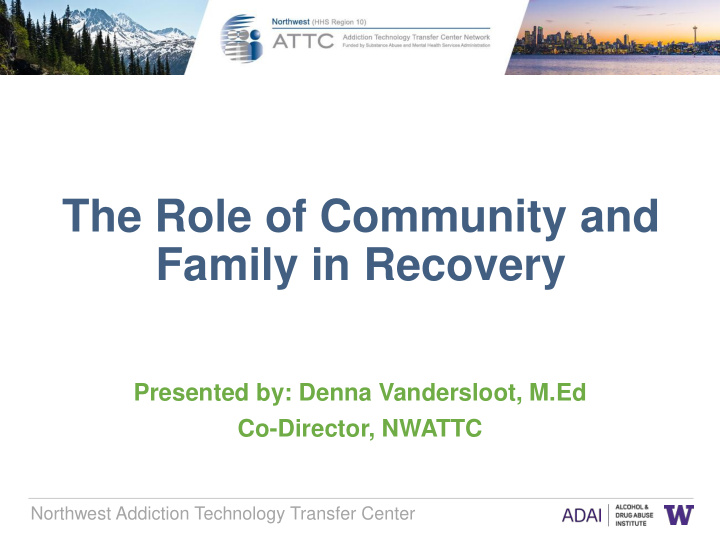



The Role of Community and Family in Recovery Presented by: Denna Vandersloot, M.Ed Co-Director, NWATTC Northwest Addiction Technology Transfer Center
Don Darrell Warren
Defining a leader….. This shift in thinking changes our question from “ A Leader is anyone who is willing to help , anyone who sees something that needs to change and takes the first steps to influence that.” ~Margaret Wheatley This Photo by Unknown Author is licensed under CC BY-SA-NC
Simon Sinek’s Golden Circle Why? How? What?
What is you WHY? 1. Find a neighbor at your table to talk with for a few minutes. 2. Identify who will talk first (you will both have a turn). 3. Spend two minutes “each” talking about your WHY . It might be about your BIG WHY Or just about your why you are here tonight. Why did you decide to come tonight? What matters to you? 4. When you hear the chimes it will be a reminder to switch roles and allow the other person to talk about his/her why.
Definition of Recovery A process of change through which individuals improve their health and wellness, live a self- directed life, and strive to reach their full potential. SAMHSA, 2011
How do individuals in recovery define recovery? Better life/new life 72 Lifelong process/working on self 24 Dealing with issues/seeking help 24 Total abstinence 31 0 10 20 30 40 50 60 70 80 Alexandre Laudette, Pathways to Long-Term Abstinence
Health is a state of COMPLETE physical, mental and social well- being and not merely the absence of disease or infirmity . World Health Organization
Factors that Influence Health Status HEALTH CARE LIFESTYLE 10% ENVIRONMENT Smoking Living Environment Obesity 51% Safety 19% Stress/Coping Housing Nutrition SES/Employment Blood Pressure Social Support HUMAN 20% BIOLOGY Arthur C. Evans Jr.
Lifestyle and Environmental Factors Account for 70% OF HEALTHCARE OUTCOMES
What do we know about Recovery? Stable alcoholism recovery is not reached until 4-5 years of sustained remission, longer for other drugs. (Jin et al, 1998) National ATTC ROSC Slides (2013)
Addiction Treatment and Recovery Continuum Recovery Pre-Recovery Recovery Long-term Initiation & Engagement Maintenance Recovery Stabilization Adapted from William White
What do we know about Recovery? Recovery can be initiated in an artificial environment . . . but successful recovery maintenance can only be achieved in a natural community environment . National ATTC ROSC Slides (2013) (Kelly, J. & White, W. (Eds., 2011). Addiction recovery management: Theory, research and practice. New York: Springer Science.)
This shift in thinking changes our question from “How do we get a client into treatment?” National ATTC ROSC Slides, 2013ATTC ROSC Slides (2013)
. . . to “How do we support a person in their recovery process?” National ATTC ROSC Slides (2013)
Rhetoric versus Reality Acute versus Chronic Disorders National ATTC ROSC Slides (2013)
The Healing Forest Photo credit flickr.com
Recovery-Oriented Systems of Care (ROSC) A coordinated network of community-based services and supports that is person-centered and builds on the strengths and resilience of individuals, families, and communities to achieve improved health, wellness, and quality of life for those with or at risk of alcohol and drug problems.
Why do we need a recovery-oriented system of care? Community Challenges 1. Countless families have been devastated by the disease of addiction. 2. People don’t know where to turn for help or how to get their loved one’s in treatment. 3. High stigma keep people isolated and suffering alone. 4. Community members who want to help don’t know how to help. 5. We often only see the disease, and seldom see recovery. Therefore families and individuals often don’t have hope that recovery is a reality for them. National ATTC ROSC Slides (2013)
Focus Groups at Pioneer Center North Individual Challenges
Four our Di Dime mensions ions of of R Rec ecover ery HOME ↑ Recovery Housing HEALTH ↓ Symptoms & COMMUNITY Individuals ↑ Peer/Family/ Distress and ↑ Abstinence, Recovery Network Families Self-Care & Supports Resilience PURPOSE ↑ Employment/ Education SAMHSA www.samhsa.gov
Recovery Capital In assisting people to achieve their recovery goals, it is often Recovery Capital helpful to help them assess and build their Recovery Capital . Recovery Capital is the sum of the strengths and supports – both internal and external – that are available to a person to help them initiate and sustain long-term recovery from addiction. (Granfield and Cloud, 1999, 2004; White, 2006)
Essential Ingredients for Sustained Recovery Safe and affordable place to live Steady employment and job readiness Education and vocational skills Life and recovery skills Health and wellness Recovery support networks Sense of belonging and purpose Nurturing relationships Community and civic engagement Slide used with permission SAMHSA, 2016
Recovery-Oriented Systems of Care (ROSC)
Hancock Ohio – Recovery Oriented System of Care
CommunityGuidelines A Community Position on the Value of Life in Hancock County Adopted February 2017 “All have their worth and each contributes to the worth of others.” – J.R.R. Tolkien ****** As a community, we embrace these truths: 1. No person is expendable. 2. Addiction is a chronic disease of the brain. 3. Each member of our family serves as the best hope for ending this crisis. 4. Prevention and treatment work, and recovery is real. When we speak this common language, we break down barriers and allow our community to heal.
“If you want to treat an illness that has no easy cure, first of all, treat them with hope” `G `George Vall llia iant
What does recovery look like and sound like? Transition Slide
Recommend
More recommend